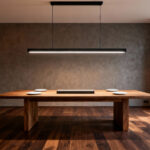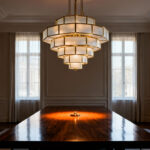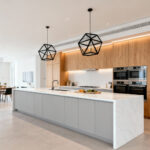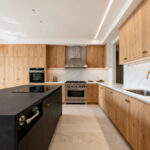For years, people have worried that a black kitchen would feel like a cave. I get it. The fear is that it will be dark, gloomy, and hard to work in. But after more than a decade of designing homes that work for everyone—from toddlers to grandparents—I’ve learned something that might surprise you: a well-designed black kitchen is one of the most practical, beautiful, and accessible choices you can make.
What I love about black is its honesty. It provides incredible depth and serves as a powerful anchor for the entire home. When we design for real life, we’re planning for changes—our eyesight might not be what it once was, a family member might need a wheelchair, or we might just want a space that feels calm and organized. Black, when used thoughtfully, does all of this. It’s not about being trendy; it’s about creating a timeless foundation.
So let’s walk through some ideas that show how this “daring” choice is actually just smart, inclusive design.
1. The Understated Power of Matte Black
Matte black isn’t just a design choice; it’s a sensory one. The surface absorbs light instead of reflecting it, which cuts down on glare significantly. This is a game-changer for people with vision sensitivities, cataracts, or who experience migraines. I’ve seen firsthand how a client’s tense shoulders relaxed when they walked into a kitchen without harsh reflections bouncing off every surface.

What’s really practical about matte, though, is how forgiving it is. Fingerprints, smudges, little splashes—they all tend to disappear on a good quality matte finish. For a busy, multigenerational home, this is huge. Less time spent wiping down cabinets means more time for everything else. I often suggest pairing matte black lower cabinets with lighter uppers. This creates a visually grounded space and naturally draws the eye, helping with navigation, while keeping the room feeling open and bright.
2. The Sleek Look of High-Gloss Black
Now, on the other end of the spectrum is high-gloss black. It’s unapologetically modern and brings a completely different energy. Its mirror-like finish bounces light around the room, which can make a small, tight kitchen feel much larger and brighter. It’s a clever trick I use in city apartments or galley kitchens. The smooth, seamless surface is also a dream to wipe down.

Frankly, high-gloss isn’t for everyone. If you have young kids with sticky fingers, you might be driven crazy by the smudges. But here’s the universal design upside: those reflections create very clear visual edges. For someone with low vision, the sharp line between a high-gloss cabinet and the wall is an unmistakable landmark. My advice? Use it strategically. Maybe on upper cabinets that aren’t handled as often, or pair them with sleek, integrated pulls or touch-latch hardware to minimize fingerprints.
3. Making a Statement with Black Countertops
If you want to dip your toe into the world of black kitchens without a full commitment, black countertops are the way to go. They create a strong, grounding horizontal line that anchors the entire room. Materials like black granite, soapstone, or engineered quartz are incredibly practical—they do a fantastic job of hiding crumbs, coffee rings, and the general messiness of a well-loved kitchen.

But this is where it gets interesting from an accessibility perspective. I always push my clients to feel the countertop options. A honed or leathered finish, which is more matte and has a slight texture, is often a better choice than polished. It reduces glare and the subtle texture provides a bit of tactile feedback, which is helpful for everyone but especially for those with vision loss. It helps you sense where the edge of the counter is. And don’t forget you can vary the heights—a lower section of that beautiful black soapstone can be a perfect, accessible baking station for someone in a wheelchair or a child who loves to help.
4. Reimagining the Classic Subway Tile in Black
Everyone knows subway tile. It’s familiar, it’s comforting. But when you render it in black, it becomes something else entirely—sophisticated, dramatic, and full of depth. The grid pattern it creates offers a subtle sense of order, which can be very calming in a busy space. For universal design, a contrasting grout (like a light gray or even white) turns that grid into a clear visual map, which helps with spatial orientation.

You can get creative here. Stacking the tiles vertically can make the ceiling feel higher. A herringbone pattern adds dynamic movement. Or, my personal favorite, mix in a few matte black tiles with the glossy ones. It creates this subtle, shimmering texture that you only really notice up close. It adds a layer of richness that feels custom and thoughtful, and that bit of texture helps diffuse light to reduce glare.
5. Warming Up Black with Natural Wood
An all-black kitchen can sometimes feel a little cold if you’re not careful. The easiest, most effective way to prevent this? Bring in wood. The combination of cool, deep black with the warmth and texture of natural wood is timeless. It’s a pairing that speaks to our innate need for connection to nature—what designers call biophilic design. It just feels good.

The contrast isn’t just visual; it’s tactile. Think about resting your hands on a warm, smooth butcher block island versus a cool stone one. For older adults or anyone with hands sensitive to cold, this can make a world of difference. On a recent project for a family making a home for an aging parent, we did matte black lower cabinets but made the entire island out of a warm walnut. It immediately became the heart of the home, a place where everyone felt comfortable gathering.
6. The Cohesive Calm of Black Appliances
For decades, stainless steel has been the default. But I’ve noticed a shift. Black appliances—especially in a matte or black stainless finish—are a designer’s secret for creating a truly seamless and calming kitchen. Instead of being jarring silver boxes, they blend right in with the cabinetry. This creates a less cluttered, more cohesive look that can be incredibly soothing for people with sensory or cognitive processing differences.

The best part is the reduction in glare. I can’t tell you how many people complain about the blinding reflection of overhead lights on their stainless steel fridge. A matte black finish eliminates that problem. This improves visibility for everyone, but it’s a non-negotiable for aging eyes. And with so many great finishes now—from fingerprint-resistant matte to deep black glass—you can find an option that is both beautiful and low-maintenance.
7. Adding a Touch of Glamour with Gold or Brass Hardware
Here’s where you can have some real fun. Putting gold or brass hardware on black cabinets is like adding the perfect piece of jewelry. It instantly elevates the entire space from simple to sophisticated. But beyond the beauty, this combination is an accessibility powerhouse.

That high-contrast sparkle makes the hardware incredibly easy to see and locate, which is a huge benefit for anyone with low vision. But don’t stop at color. The shape of the hardware is just as important. I always recommend D-pulls or lever-style handles over small knobs. They’re so much easier to use if you have arthritis, limited hand strength, or are just trying to open a drawer with your elbow because your hands are full. It’s one of those small details that makes a massive difference in daily life.
8. The Black Island as Your Kitchen’s Anchor
In an open-concept floor plan, a black island can solve a lot of design challenges. It creates a bold, clear focal point that defines the kitchen zone without needing walls. For anyone navigating a space—whether a child, an older adult, or someone with vision loss—that big, dark landmark says, “Here is the kitchen.” It’s an intuitive wayfinding tool.

When we design an island, we’re really designing a multi-functional hub. A multi-level island with a lower, accessible countertop for seated prep work is one of my go-to solutions for multi-generational homes. Just be sure to leave adequate clearance—at least 42 inches—around it for easy traffic flow and wheelchair access. And a simple trick: install a thin strip of LED lighting under the countertop overhang. It not only looks stunning but also clearly illuminates the island’s edge for safety.
9. Playing with Texture to Add Depth
A common mistake is thinking of “black” as a single color. It’s not. It’s a whole world of possibilities, and texture is where it gets really exciting. A wall of flat black can feel like a void, but a wall of fluted or reeded black cabinetry? That’s alive with light and shadow. The texture adds dimension and provides crucial tactile information.

Think about surfaces like Zellige tiles, with their beautiful, subtle handmade variations, or a stone countertop with a rich, leathered finish. These elements invite you to touch them. They make the space feel more engaging and defined. For someone navigating by touch as well as sight, these textural differences between surfaces are incredibly helpful cues. It’s a way to build a richer sensory experience that goes way beyond just the visual.
10. The Unbeatable Clarity of Black and White
There’s a reason black and white is a timeless classic: it just works. But it’s more than a style choice; it’s fundamentally accessible. Our eyes are built to see contrast, and nothing provides more clarity than black against white. This stark difference creates clear visual boundaries that make a kitchen easier and safer to navigate for everyone, especially those with vision impairments like macular degeneration or diabetic retinopathy.

To make this pairing work for universal design, think in zones. Black base cabinets ground the space, while white upper cabinets keep it feeling bright and open. A black countertop on white cabinets (or vice-versa) clearly defines your work surface. The key is to avoid making it feel too sterile. Bringing in those wood tones or warm metal accents we talked about earlier will soften the look while maintaining the functional benefits of that brilliant contrast.
11. Going All-In with a Monochromatic Black Design
An all-black kitchen sounds intimidating, right? But done correctly, it’s not oppressive—it’s enveloping. A monochromatic black space can feel like a quiet, cozy retreat. By minimizing sharp visual contrasts within the space, you create an environment with less visual noise. This can be a huge relief for people who are sensitive to sensory overload, including those on the autism spectrum or with ADHD.

The secret to a successful all-black kitchen is layering. You can’t just paint everything the same flat black. You have to mix finishes and textures. Matte black cabinets, a high-gloss black backsplash, leathered granite countertops, and black-stained oak floors—they’re all black, but they look and feel completely different. Strategic lighting becomes critical here to sculpt the space and highlight those subtle differences, ensuring it feels layered and sophisticated, not flat.
12. Using Black Lighting to Define Your Space
Think of lighting fixtures as more than just a source of light. They’re punctuation for your room. Black light fixtures, in particular, serve as powerful visual anchors. A cluster of black pendants over an island clearly says, “This is a gathering spot and a work zone.” A single black sconce next to the pantry can signal “storage.”

This kind of visual cueing is at the heart of intuitive design. It helps everyone understand the layout and flow of the kitchen without a moment’s thought. Against a light-colored ceiling or wall, black fixtures provide strong contrast, making them easy to see and further helping to define the kitchen’s perimeter. It’s a simple, stylish way to add another layer of functional organization to the space.
13. The Natural Honesty of Black Stone and Concrete
I have a real soft spot for natural materials. Black stone and concrete countertops bring an organic, earthy element into the kitchen. The inherent variations—the subtle veining in a slab of Negresco granite or the tonal shifts in a hand-poured concrete counter—give the surface life and visual interest. This prevents it from looking like a flat, black hole.

Again, I lean toward non-polished finishes. A honed or leathered surface doesn’t just reduce glare; it feels wonderful to the touch and wears beautifully over time, developing a unique patina. These materials are also incredibly durable, which is a must in a universal design setting where they might come into contact with mobility aids or adaptive equipment. The longevity of these materials means you’re designing for the long haul, which is both sustainable and smart.
14. Creating a Gallery Wall with open shelving
Not ready for black cabinets? Try black walls. It’s a less permanent way to bring in drama and depth. Then, mount light-colored open shelving against that dark backdrop. What happens is magical: your everyday dishes, glasses, and bowls suddenly look like curated art pieces.

This isn’t just about aesthetics. Open shelving is a win for accessibility. It eliminates the physical barrier of a cabinet door and lets you see everything at a glance. No more digging around in a dark corner cabinet. I advise clients to place their most-used items on the lowest, easiest-to-reach shelves. For someone with memory challenges, having everything visible can be a helpful reminder. For someone with limited mobility, it means less reaching and straining.
15. The Industrial Chic of Black and Stainless Steel
Combining black with stainless steel creates a look that feels professional, durable, and seriously stylish. The black elements—whether cabinets or a backsplash—add a layer of warmth and sophistication that keeps the industrial vibe from feeling too cold or institutional, like a commercial kitchen.

This is a really practical pairing for a home that needs to be a workhorse. Stainless steel countertops are almost indestructible and incredibly hygienic. Matte black cabinets can hide smudges and reduce glare. The visual contrast between the two materials also creates those important visual cues we’ve been talking about, helping to delineate different zones and surfaces. It’s a look that says “this kitchen is ready for anything.”
16. Making Things Pop with a Splash of Color
A black kitchen is the perfect canvas for color. Strategic pops of a vibrant hue—a turquoise Smeg fridge, a set of sunny yellow bar stools, a backsplash of bold red tile behind the stove—can add so much personality. But these splashes of color can also be functional landmarks.

Instead of scattering color randomly, use it with purpose. Color-coding can be a brilliant and intuitive wayfinding tool. For example, maybe you paint the inside of the pantry cabinet a bright green, so it’s easy to spot. Or you choose red for the hot water tap handle. These small, thoughtful uses of color can make a space significantly easier to navigate for someone with cognitive differences or vision loss, while also making the space feel uniquely yours.
17. The Quiet Calm of a Minimalist Black Kitchen
Minimalism isn’t about having less; it’s about making sure that what you have is meaningful and functional. A minimalist black kitchen, with its clean lines and lack of visual clutter, can be an incredibly serene and accessible space. By getting rid of extraneous details, you create a calming environment that allows the brain to focus on the task at hand.

This look often features handleless cabinets with push-to-open mechanisms or integrated pulls, which are fantastic for people with limited hand strength. Appliances are often integrated behind matching cabinet panels, creating an uninterrupted visual flow. This aesthetic of “less is more” is also wonderfully future-proof. An uncluttered design can more easily accommodate adaptive equipment or modifications later on without feeling disruptive.
18. Grounding Your Kitchen with Dark Flooring
Just as a dark island can anchor a room, so can a dark floor. Black or dark gray flooring creates a strong, solid foundation for the entire space. From a universal design perspective, this is a golden opportunity to create contrast. A dark floor paired with light-colored lower cabinets or a white island provides a crystal-clear visual edge, reducing the risk of trips and falls.

The material choice is key. You’ll want a slip-resistant finish for safety—a matte porcelain tile, luxury vinyl plank, or even rubber or cork flooring can be excellent choices. High-gloss floors in a kitchen are, in my professional opinion, a safety hazard waiting to happen. A dark, matte floor not only grounds the room visually but also provides a safer, more comfortable surface for everyone.
19. The Art of Mixing Black Finishes
This is where the real mastery of a black kitchen comes into play. It’s not just one finish; it’s a symphony of them. Imagine how morning light would hit a space that combines matte cabinet fronts, a strip of glossy tile, and a textured, leathered countertop. Each surface would catch the light differently, creating a rich, dynamic, and layered environment.

This mix-and-match approach is a feast for the senses. It provides both visual and tactile variety, which helps distinguish different zones and surfaces without relying on color alone. You might use a smooth, glossy finish on a surface you want to reflect light, a deep matte on a large area to create calm, and a tactile texture on an edge or handle. This multi-sensory design approach is the essence of what it means to create a space that truly works for everyone.
Conclusion
So, you see? A black kitchen is so much more than a dramatic style choice. It’s a canvas for creating a space that is profoundly functional, deeply personal, and inherently inclusive. By focusing on contrast, texture, lighting, and thoughtful details, you can build a kitchen that will not only look stunning for years to come but will also support you and your family through all of life’s changes. That’s not just good design—it’s a beautiful way to live.






